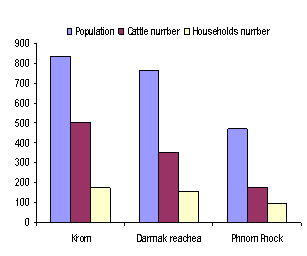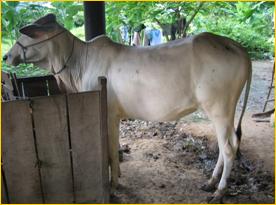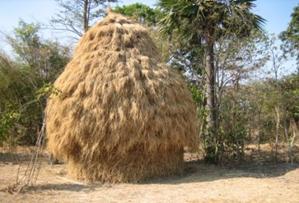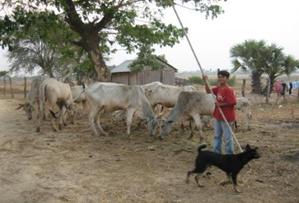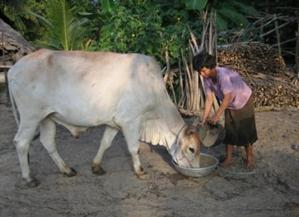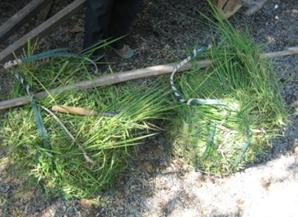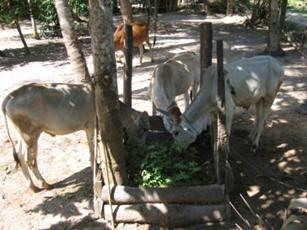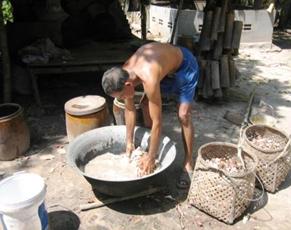Survey on feed utilization for cattle production in Takeo
province
Keo Sath, Khieu Borin and T R Preston*
CelAgrid, Cambodia
keosath@celagrid.org
*Finca Ecológica,UTA-Colombia, AA#48, Socorro,
Santander, Colombia
Abstract
A survey was conducted in three villages of Treang district
Takeo province. The Participatory Rural Appraisal (PRA) method was
applied for collection of data on cattle production, and
availability of feed resources by season. Twenty-five farmers both
men and women participated in the study. Among the twenty-five
families, fifteen households that kept cattle were interviewed to
obtain information related to cattle production such as breeds,
marketing flow, and management techniques.
The cattle in the area were mainly Bos indicus, among
these about 68 % were crossbred with Haryana and 31.8% were of the
local "Yellow" breed. Cattle production was primarily for draft
power with meat production and manure as fertilizer for crops a
secondary consideration. The draft power served for soil
preparation for growing rice which is the common practice through
out the area. The numbers of cattle per households were: 3-5 heads
(73.9%), more than 5 heads (8.7%) and 1-2 heads (17.4 %). The
calving rate was 66%.
Food and Mouth Disease and Haemorrhagic Septicaemia appeared to
be an occasional problem in this area. During the cropping season,
the cattle are tethered at homestead or in small plots of land
nearby the house and supplemented with rice straw or cut and carry
grasses. Feed resources for cattle are natural grasses, rice straw
and shrubs, which are collected from the rice field. The fruits and
leaves of the sugar palm, and rain tree, bamboo, manila tamarind
and cassava products are used when grass or by-products are not
sufficient. No technologies to improve feed quality had been
introduced. There had been no introduction of new forage species.
All the farmers followed the traditional management system. Low
quality and shortage of feed appeared to be the major constrains
for cattle keeping during the period February to April.
It is concluded that cattle production in the study area is
directly associated with rice cultivation and this relationship is
important for optimizing profit. Feed utilization depends on what
is grown by the farmer and may be the main factor limiting how many
cattle kept in each household. There is a need to focus on ways to
improve the nutritive value of feed resources and on introducing
forage trees with high nutritive value and biomass yield.
Key words:Cattle, feed utilization, management,
PRA, small-holder farms
|
|
Introduction
Livestock and crop farming are the major sources of food and
income in rural farm households. Farmers are raising different
kinds of livestock in order to satisfy their needs. Cattle are
found concentrated in the rice growing areas of Cambodia. The
majority of the farmers kept 2-3 cattle to provide draft power,
organic fertilizer, and cash saving. The sale of an adult animal
would be enough to cover the loss of a wet season rice crop
(Maclean 1998).
Many different factors affect the profitability of cattle
keeping including seasonal condition, nutrition, family labour
availability, marketing and health control. Feeding strategy is one
component of the overall management strategy for livestock. In
traditional system, cattle eat what available. Availability of feed
resources is very dependent on season and land utilization. The
quantity and quality of available feed resources affects the
performance and value of cattle. During periods of abundant feed
supply, cattle are in good body condition. Utilization of crop
residues and other forages and/or tree leaves is the most
appropriate way for production of ruminants according to Preston
and Leng (1987) and Leng (1997).
Indigenous knowledge, the socio-economic situation and attitudes
of the rural farmers should be taken into consideration when
planning for rural livestock improvement. It can help
communitarians and outsiders to make the best development
decisions. Practical field experiences show that impressive results
can be achieved when farmers and outsiders have a strong commitment
to work together and share ideas (Haverkort 1991).
To understand the way that cattle production is practiced by
rural farmers and how indigenous knowledge is used in their
condition need to be investigated. The purpose of this study was to
investigate the availability of feed resources by season, the
traditional methods practiced by rural farmers for cattle
production, and the nature of problems encountered and the solution
farmers preferred.
Materials and methods
Location, duration and activities of the assessment
The survey was conducted in three villages of Treang district,
Takeo province. The village selection was primarily based on cattle
keeping and cassava growing. The village were Damnak Reachea, Phnom
Pnock, Krom from different communes of Treang district. Phnom Pnock
village represented the area where farmers are growing cassava,
whereas Danak Reachea and Krom village represented high and low
population of cattle in Treang district.
The duration of the assessment was from April to October 2006. A
team of researchers (4 persons) spent 3 days in each of the three
villages to collect data using the Participatory Rural Appraisal
(PRA) tools/methods and to interview family households. A week
before applying PRA, the local authorities of those villages were
informed about the study and asked for their advice.
Participants
There were twenty-five farmers, men and women, who participated
in the data and information survey in each village. Among the
twenty-five families, fifteen who kept cattle in each village were
selected for interview. The selection of farmers was done according
to their interest and willingness to cooperate with the
researchers.
The PRA team was trained for 2 days before conducting the
exercise so that the researchers learned to understand the
questionnaires and tools of PRA.
Methodologies
General data were collected through Participatory Rural
Appraisal (PRA) methods. The secondary data of each village were
collected from the local authorities. The farmers were divided into
small groups and under the guidance of the researchers they
discussed the different activities related to cattle keeping and
feeding. The PRA tools that were used included mapping, a transect
walk, seasonal calendar, focus group discussion (men and women),
direct observation and individual family interview using
questionnaires. At the end of the PRA, the results were fed back to
the farmers to review and clarify the information collected.
Data collection
The following information and data were
collected:
-
Cattle breeds
-
Cattle production system
-
Availability of feed resources by seasons (rainy and dry season)
-
Using cassava for cattle feeding
-
Availability of technologies, perception and adaptation for cattle production
-
Management, care and feeding of cattle by seasons
-
Diseases control and prevention
-
Availability and access to markets and price of cattle
Results and Discussion
Description of study area
Takeo province is one of the major rice producing areas of
Cambodia. It is about 80 km South of Phnom Penh city. Takeo borders
with Vietnam in the South, with Kampong Speu and Kampot in the West
and in the North with Kandal province. There are 165,878 households
in the province with a total population of 848,953 (440,486
females). From 85 to 90 percent of the population depend on
agricultural activities (provincial report 2003). There are two
seasons; the rainy season starts in May through to October and the
dry season from November to April. The mean temperature is 28
degrees Celsius. Some areas in Takeo province suffered flooding and
drought in 2003. Treang district is one of 10 districts of Takeo
province. It extents to 41,286 ha of land and is about 9 km from
the centre of the province. Rain-fed rice cultivation is the main
source of income of the farmers.
Damnak Reachea village is located in Prambey Mum commune of
Treang district. There are 157 households with a total of 765
population (53% female); among those women head 25 households.
There are 145 households raised cattle of 350 heads, 63.6 percent
of households kept pigs among those 12% of households kept adult
pigs (3-5 heads) and 76 % of total households kept poultry (5-6
heads). Rice cultivation is the main occupation. Twenty-five
percent of total households own less than one ha of rice field. The
average yield of rice was 1.3 tonnes per ha and the price 400-600
Riels/kg (Village reported 2006).
Phnom Pnock village has 95 households with a total population of
472 (50% female); among those women head 20 households. The village
is located in Prey Slek commune of Treang district. Seventy-three
households keep cattle (173 heads), 71.5% of households kept pig
among those 17.6% of households kept adult pigs (3-5 heads), and
76.8% kept adult poultry (5-6 heads). In this village, rice
cultivation is the source of income followed by cassava cultivated
in the backyard mainly for root production. The average yield of
rice was 1.5 tonnes/ha and the price 620-650 Riels/kg (Village
reported 2006).
Krom Village is located in Sanlong commune of Treang district with a total of 837 people (50.5% female) in 173 households. Among these, 10 households are headed by women. One hundred sixty nine households keep 500 heads of cattle. This village is occasionally flooded in the rainy season. The average rice yield is 0.8 tonnes/ha and the price of paddy was 400 Riels/kg (Village reported 2006). Rice cultivation was also the main occupation followed by fishing as well as animal production. Ten families in this village owned less than one ha of rice field.
|
|
|
|
Figure 1: Population and cattle numbers in the village |
Figure 2: Percentage of households keeping livestock in three villages |
Cattle production systems
The cattle production is directly linked with crops and farming
activities. Most farmers cultivate rice one time per year, starting
from May through to October. Among interviewed farmers 17.4 % keep
1-2 cattle, 73.9% keep 3-5 cattle and 8.7 % keep more than 5 cattle
(Table 1). In practice, besides having animals for agriculture work
such as plowing, leveling and transporting, farmers also use cattle
manure as fertilizer for their crops.
Cattle are kept primarily for draft power with meat production a
secondary consideration. Working cattle are like family car/truck.
Adult male cattle at 3 years of age are trained to be used in pairs
for draft purposes. Males are usually castrated at the age 1.5-2
years. Female cattle are not used as draft animals in the selected
villages for this survey. The main reasons are that farmers
consider that female cattle are weak, small and they are kept
mainly for breeding purposes. In addition, women do not want to see
their cows working hard as they wish to care for them mainly for
breeding and manure. The main use of draft animals is the soil
preparation for the rice crop which is the common practice and has
been for generations. In cropping time, draft animals are used for
pulling carts, transporting manure to the rice field, plowing and
leveling. In harvesting period, they are used to transport paddy
and rice straw to the homestead. Some farmers also use them for
threshing. Draft animals work from early morning until noon and are
then taken to the grazing area in the afternoon.
Cows are commonly mated to produce their first calf at 2.5 to 3
years of age. If fed poorly, they may have their first calf at 4
years of age. There is considerable variation in this according to
breed and nutrition. Mating season in these villages is usually in
the early rainy season (April- May), when there is plenty of feed
such as grasses and forages. Under the farmer condition, a calf
slowly weans itself and it is independent from its mother at the
age of 12 to 15 months. Some farmers kept their cows in good
condition at calving and gave good feed during the post calving
period. In this case, cows may come into heat and be pregnant
within three months after calving. With good care, management and
feeding, a cow may have one calf annually. However, this is not
usually the case. Cows are usually in poor condition at calving and
lack of feed post calving. Most farmers said that their cows have
two calves every three years, or on average 18 months (calving rate
66%). Bouy and Dasniere (1993) reported that calving rate was from
39% to 56% in a village in the river bank area.
Cattle are freely grazed in the rice field at the beginning of rainy season (February to May) and post harvest (November to January). When cropping takes place cattle are usually tethered at home or in the small plot of land nearby the house because there is no available land for grazing and it may damage the crop if cattle are set free. Cattle are commonly kept under farmer's house at night-time. The cut and carry system is used when cattle have no access to grassing areas.

Cattle breeds and breeding
The common breed found in the study areas is Bos indicus.
The local breed constituted 31.8% of the total number of cattle in
the three villages whiles the crossbreds constituted 68.2%. Local
cattle are called Gor Srok or Gor Khmer. This breed
has small body size and a small-hump, similar to the local cows of
neighboring Thailand. It has a short neck and length between
1.5-1.7 meters. It is characterized by the colour which is yellow,
maroon or red and the mature weight about 250-300kg. It can survive
in the region with limited supply of feed of poor quality and
adapts very well with the local environment, as well as being
resistant to diseases including parasites. This breed is
predominates in the northeast provinces in both upland and lowland
areas of Cambodia.
Haryana and Brahman were introduced to Cambodia from about 1960s
and 1980s. Haryana is tall, narrow-shoulder, and is therefore a
good walker and popular with farmers for draft purposes. Crossbreed
(Haryana x Local cattle) were found in areas with availability of
feed year round. Crossbreed of Brahman x Local cattle were less
evident than Haryana crosses. Crossbreds are favored because of
their good appearance and their draft and walking ability. All
farmers in these villages practice natural breeding. Mating cows
can occur two ways. It may occur freely in the field, when mixing
with other cattle, either from a bull which is a poorly castrate
male, or a young male that has reached puberty but not yet been
castrated. Alternatively, cows are brought to a bull, which is kept
for breeding. To hire a bull for a service, the fee can vary from
US$4 to 6.5 depending on the area and quality of the bull.
|
|
|
|
Photo 1: Local yellow cattle |
Photo 2: Crossbred cattle (Haryana x Local cattle )
|
Feed resources and feed utilization in cattle production in village
Feed resources and the methods of using them were found to be
similar for the three villages (Table 2, 3 and 4). Feed resource
included grasses, rice straw, rice bran, sugar palm fruit and
juice, banana stems and leaves, cassava by-products, leaves from
the shrubs and local plants such rain tree, bamboo and manila
tamarind. Working animals, pregnant cows and cows after calving are
given better care and attention. The main feeds for cattle in these
villages are native grasses and rice straw. Grasses are scare from
February to April because they become very dry and die out in the
open fields. Rice straw is used almost year round but is scare from
October to December. Rice straw is collected from the paddy field
and stacked in a high area near the house (Photo 1). Rice bran and
tree leaves are occasionally fed to cattle and mainly for working
animals during pre-cropping and cropping period. In the case of
tree leaves, they are abundant after the first rains. Leaves from
the rain tree, bamboo, and manila tamarind are used in cut and
carry system particularly when grass and crop by-products are not
sufficient. Rice bran is usually mixed with water in ration of
1:3-6 and fed to cattle. Banana stems and leaves were provided
during the dry season (February to April). Farmers also use some
palm fruit and rain tree ripe fruit for supplementation (Photo 2)
to cattle when these are available. Rain tree ripe fruit are
available from March to April while palm fruit starts to mature
from July to October. Some farmers produce sugar palm juice for
human consumption and they may spray the juice on the rice straw
before feeding it to cattle. The juice makes the straw more
palatable and also provides some energy. The mature fruits are also
fed. The fruits are soaked in water and wiry fiber taken out. The
suspension of yellow pulp is given to the cattle. Fresh grass is
available in the fields after first rains. To take advantage of it,
cattle are allowed to graze during the day and then return to the
house in the evening, where they are fed rice straw. The feed in
the fields disappears progressively when plowing of fields begins.
During the cropping season (August to November), cattle are
gathered in groups by children during the day and taken to a higher
grazing area if available, or they are kept at the house all day.
When kept in the house, they will be fed rice straw and some cut
and carry feed. During this period the reserves of rice straw start
to get low, and there is some rice straw trading in the villages.
In the post harvest period, cattle are freely grazed in the paddy
fields, consuming stubble which is left over and some
shrubs.
|
|
|
|
Photo 1: Storage of rice straw for feeding cattle during
season of feed shortage |
Photo 2: Farmer shaking ripe fruits of Rain tree
(Adenanthera pavoninal Leguminoseae) to cattle
|
|
|
|
|
|
|
|
Photo 3: Feeding rice bran with water to working
cattle |
Photo 4: Cut and carry grasses from the rice
bunds |
Farmers in Phnom Pnock village also feed cassava foliage to
their cattle. After harvesting roots of the "6 months" variety the
leaves are collected for their cattle. Normally, villagers grow
cassava in May or after first rains. The harvest of roots starts
from September through to November. Roots are collected and cooked
for selling in the roadside while the outer skin of the root is fed
fresh to the cattle.
|
|
|
|
Photo 5: Feeding cassava foliage to young cattle
|
Photo 6: Farmer cleans cassava root outer skin for
feeding cattle |
The extent of feeding management largely depends on the farmer's activity, household income and is greatly affected by crop seasons. The cattle are in a certain place at certain time and what they eat is a function of what is available in that place at that time. Feeding of fibrous residues such rice straw to cattle in this area are appropriate and economical for smallholder farms (Preston and Leng 1987; Leng 1997) but it is inadequate for efficient rumen fermentation when used alone due to lack of essential nutrients and low digestibility (Leng 1997). There have been many studies on enhancing digestibility and nutrient availability of straws (Singh et al 1988; Preston and Leng 1987; Wanapat et al 1985; Nuyen Xuan Trach et al 2001). In the survey villages it was observed that the farmers try to improve intake of straws by mixing greens feed, soaking the straw in water and spraying sugar palm juice or salt solution on the straw.

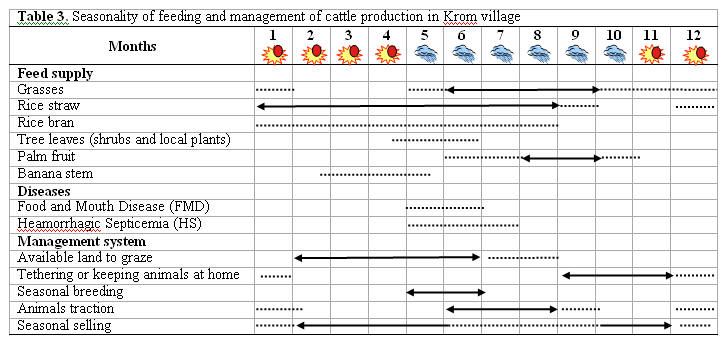
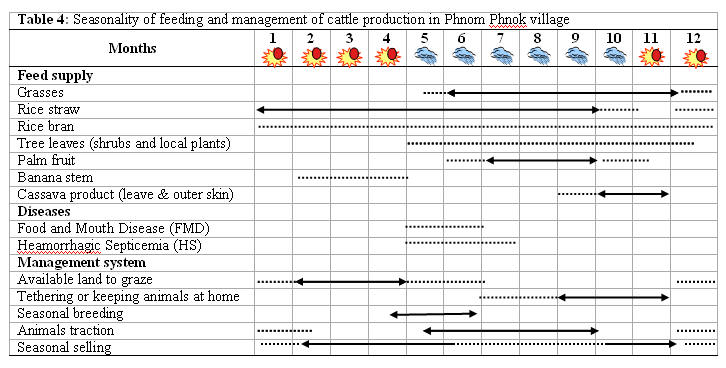
Disease control and prevention
The main diseases of cattle in these areas are Food and Mouth
Disease (FMD) and Haemorrhagic Septicaemia that appear during rainy
season, especially in early rainy season. An outbreak of these
diseases appears to be due to sudden change in the weather in early
rainy season, the hard work of plowing, or appropriated conditions
for large-scale spread of the disease. The clinical signs of FMD
are sore feet, lameness and salivation while Haemorrhagic
Septicaemia is indicated by swelling of the throat, head and
stomach, with high fever. Mortality rates of FMD are low except in
young calves. Disease appearance in cattle has significant economic
effect due to cost for treatment, or death. An outbreak during the
plowing or other working periods causes delay in cropping
activities resulting in a shortage of working animals and some
farmers have to hire cattle from other farmers to plow. To prevent
an outbreak of these diseases, cattle are occasionally vaccinated
by provincial veterinarians. Among interviewed farmers 15.2 % of
households did not vaccinate their cattle (Table 1). Some farmers
do not understand the importance of vaccinating their cattle, or
not enough information made available in time so that farmers are
prepared for the vaccination campaign. De-worming is not practiced
in these villages because animals appear to be healthy and
de-worming requires cash.
Marketing and market accessibility of cattle
Markets for cattle are plenty, both locally and for export. In the last few years, cattle have been legally and illegally exported to Vietnam with a higher price than when sold locally. However, there is now a strict control for animals for export. Normally, buyers visit the villages at the beginning of rainy season and after harvesting to look for farmers who want to sell their cattle. In the study area, 40.2 % of farmers preferred to sell their cattle through middlemen, 48.9 % to other farmers (producers) and 0.9 % to slaughter house. Sixty six percent of working cattle are sold to middlemen while 34.3% are sold to farmer (producer), whereas cows, heifers, steers were sold to mainly among farmers (Table 5). Farmers sell cattle when they need cash for the wedding of their son or daughter, for buying fertilizer or other immediate needs. Cattle are not sold by weight but usually through an agreement between the owner and buyer. The prices of the local breed were lower than for crossbreds. A heifer about 200 kg may cost approximately 800,000 to 1,000,000 Riels for local breed and the 1,200,000 to 1,500,000 Riels for crossbreed cattle in 2006. The price of local cattle during the period of this study was four times higher than reported by Khieu Borin et al (1996) (200,000 to 250,000 Riels). Young females command a premium price, which may be up to 30% higher, than the price for young males. The price of cattle varied depending on judgments on body size, tail, color, teeth, temperament and behavior, and marks on the body. The local knowledge of farmers was important for keeping cattle and they believed that when cattle appear with good marks, they bring prosperity and happiness for the family. Cattle are also sold to markets when they die by an accident or diseases.

Conclusions
Based on the survey, it is concluded that:
-
Mostly farmers keep small numbers of cattle (3-5 heads) due to limited of feed resources
-
Crossbred (Local cattle x Haryana) appear to be the dominant breed
-
Feeding is mainly based on crop by-products and natural grasses
-
There is a lack of extension services to improve feed quality and therefore the performance of the animals
-
The occasional diseases on cattle in this area were FMD and Haemorrhagic Septicaemia, which appeared in early rainy season, which consequent effects on cropping activities
-
Cattle production is now receiving more attention by farmers due to increasing demand for red meat locally and in the region
Acknowledgements
The authors are grateful to the MEKARN project, financed by the
Sida-SAREC agency and the PRA team for data collection. Thanks are
also due to farmers in Treang District, Takeo province, who spent
their valuable time to provide information during the Participatory
Rural Appraisal exercise. Thanks also due to the local authorities
for help in selection of villages and provision of secondary
information.
References
Khieu Borin 1996 A study on the use of sugar palm tree (Borassus flabellife) for different purposes in Cambodia. MSc. Thesis in : Sustainable Livestock Production, Swedish University of Agriculture Sciences, Uppsala.
Bouy M and Dasniere J 1993 L'Engraissement du Porc en Milieu Familial. Resultat d'un suivi sur quelques elevages. Veterinaires Sans Frontiere, Cambodia. In : Livestock in Cambodia Rice Farming Systems (Maclean M 1998)
Haverkort B 1991 Farmer experiments and participatory technology development. Intermediate Technology Publication, London.
Leng R A 1997 Tree foliage in ruminant nutrition. FAO,
Animals Production and Health Paper. 139
Maclean M 1998 Livestock in Cambodian Rice Farming Systems, (Phnom Penh: Cambodia-IRRI- Australia Project)
Nguyen Xuan Trach, Magne Mo and Cu Xuan Dan 2001 Effects
of treatment of rice straw with lime and/or urea on responses of
growing cattle. Livestock Research for Rural Development 13(5)
http://www.cipav.org.co/lrrd/lrrd13/5/trach135.htm
PrestonT R and Leng R A 1987 Matching Ruminant
Production Systems with Available Resource in Tropics and
Sub-Tropic. Penambul books: Armidale P.O. Box 512, Armidale, New
South Wales 2350, Australia.
Singh K, Flegel T and Schier J B 1998 Biological, chemical
and physical treatment of fibrous crop residues. Proceedings of an
workshop held under auspices of the Indo-Dutch Project on
"Bioconversion of crop Residues", January 20-21, 1987, ICAR, Krish
Bhaven, New Delhi, India
Wanapat M 1985 Improving rice straw quality as ruminant
feed by urea treatment in Thailand. In: Wanapat M, Devendra C
(Eds), Relevance of crop residues as animal feed in developing
countries.
